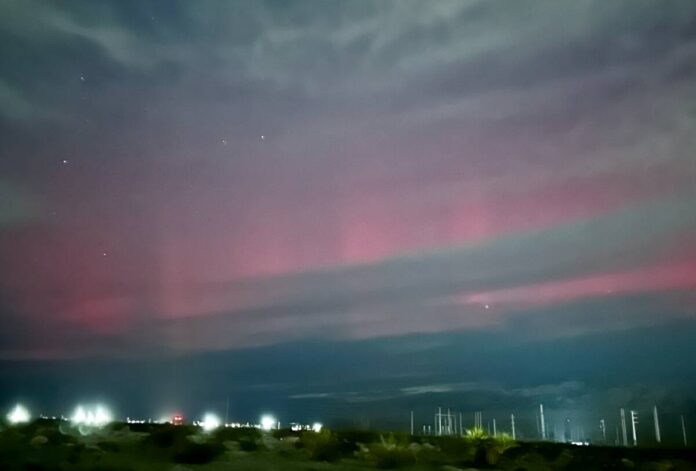On a seemingly ordinary Tuesday night, residents of the Las Vegas Valley were treated to an extraordinary spectacle: a stunning purple-hued sky resulting from a severe solar storm. This vibrant display wasn’t due to secret military tests at nearby Area 51 or an incoming storm system from the Pacific. Instead, it was the mesmerizing aftermath of a solar phenomenon that has captivated skywatchers across North America.
The lights were particularly visible in the Kyle Canyon Road area along Interstate 11, where both motorists and local residents stopped to gaze up at the dazzling auroras. “It’s always rare to see something like that at Las Vegas’ lower latitude,” noted Chris Outler, a representative from the National Weather Service. Despite working in the heart of Las Vegas, he hasn’t had the opportunity to witness such a sight from his office but confirmed that the agency had received reports from excited locals about the spectacular light show.
This recent display can be attributed to multiple bursts of energy known as coronal mass ejections (CMEs) that the sun emitted in the days leading up to the event. These intense solar explosions reached Earth, particularly impacting areas much farther south than usual for aurora sightings. According to reports from the Associated Press, such solar storms not only create beautiful light displays but also have the potential to disrupt communications, including radio and GPS signals.
The Science Behind the Aurora
The occurrence of northern lights, or auroras, typically happens near the polar regions where charged particles ejected by the sun collide with Earth’s atmosphere. As the sun is currently at the peak of its 11-year solar cycle, these light displays have become increasingly more common and visible across wider geographical areas. Experts anticipate that these celestial dances will continue to grace the skies for the foreseeable future.
Historically, last year witnessed the strongest geomagnetic storm in two decades, resulting in breathtaking light shows that mesmerized audiences well beyond the Arctic Circle, including cities such as New York and London. As scientists monitor the sun’s activity, they expect this current period of heightened solar activity to persist, although the specific peak timing remains uncertain.
Impact of Solar Storms on Earth
The effects of solar storms extend beyond mere visual splendor—they can significantly influence our daily lives. When charged particles collide with Earth’s magnetic field, they can lead to power grid disruptions and interference with satellite communications, impacting air traffic control and navigational systems. Historical events showcase the immense power of solar storms; in 1859, one such storm caused auroras visible as far south as Hawaii and even ignited telegraph lines. In 1972, another solar episode may have triggered magnetic naval mines off the coast of Vietnam.
Despite extensive research, predicting solar storms months in advance remains a challenge. Instead, scientists can only alert relevant parties a few days before an expected solar outburst, allowing cautionary measures to be implemented.
How to Experience Auroras Yourself
If you wish to catch a glimpse of the northern lights, various forecasting resources are available, such as NOAA’s Space Weather Prediction Center website and specialized aurora forecasting applications. Finding a quiet, dark space far removed from city lights maximizes your chances of spotting an aurora. Ideally, national or state parks provide optimal conditions for sky watching, but don’t forget to check the weather; cloudy skies can obstruct your view entirely.
Interestingly, if you find yourself unable to see the auroras with the naked eye, photographing with a smartphone or camera may reveal details that are otherwise hidden from your view. So, whether you’re a seasoned skygazer or a curious onlooker, the right conditions and a little patience can make all the difference in your aurora-watching experience.
The Associated Press contributed to this reporting.
